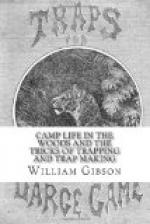American dealers divide our native furs into two classes, viz., home and shipping furs; the former being chiefly utilized in our own country, while the latter are exported to all parts of the world. New York City is the great fur mart and depot for the shipping trade in this country, and the annual value of its exports, in this one branch of trade is enormous.
The principal shipping furs are the silver, red and cross Fox, Wild Cat, Raccoon, Fisher, Muskrat and Skunk.
Among the home furs are the Marten, Mink, Opossum, Wolf and Muskrat, the latter being extensively used both here and abroad.
In the following chapter will be found more detailed notes on the leading American furs, including their various uses and the different countries for which they are the especial staples.
In order to give the reader some idea of the variety and magnitude of the yield of furs from our own country, we annex a table (p. 282) showing the sales of the Hudson’s Bay Company, at London, in the year 1873.
MARKET VALUE OF FUR SKINS.
Below will be found an authentic table of the comparative values of the various American furs at the present date of publication. The quotations are those of one of our largest fur dealers, as published in “THE HAT, CAP AND FUR TRADE REVIEW,” the leading journal of the trade in America. Of course these values are constantly varying—keeping pace with the eccentricities of fashion and the demands of the fur trade; but [Page 282] the table will serve at least to gauge the relative values, as between the two extremes of common and scarce furs. The fur market is a great deal like the stock market. It is constantly fluctuating, and a fur which is to-day among the novelties, may next year find itself on the low priced list. The demand for furs of any kind is nearly always governed by fashion, and of course the value is estimated on the demand. If the convention of fur dealers should decide to usher in Muskrat fur as the leading and most fashionable article in that line, the fashion would create the demand, the demand would be in turn supplied by the trappers throughout the country, and in proportion as the Muskrat skins became scarce, so their value would increase. In this way a skin which may be worth fifty cents at one time may soon acquire a value of twenty times that amount. The comparative value of skins is, therefore, constantly varying more or less; but the annexed table (page 283) will be found useful for general reference, and for approximate figures, will probably answer every purpose for some time to come.




